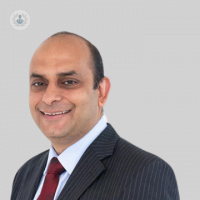Rotator cuff tears: Causes, symptoms and more
Autore:The rotator cuff is a group of muscles and tendons around the shoulder joint. It provides stability and allows for a wide range of motion. Tears to the rotator cuff range from partial to complete. Here to explain them in further detail is leading orthopaedic shoulder, elbow and hand & wrist surgeon Mr Arvind Mohan.

What are rotator cuff tears?
A rotator cuff tear involves damage to the group of muscles and tendons that surround the shoulder joint, providing stability and enabling a wide range of motion. Tears can be partial, where only a portion of the tendon is damaged, or complete, where the tendon is severed from the bone.
What causes rotator cuff tears?
Rotator cuff tears can result from acute injuries or degenerative changes. Acute tears often occur due to sudden, forceful movements such as lifting heavy objects or falling on an outstretched arm. Degenerative tears develop gradually over time due to repetitive stress, ageing, and wear and tear on the tendons. Risk factors include repetitive overhead activities, smoking, and a family history of shoulder problems.
What are the symptoms of a rotator cuff tear?
Common symptoms of a rotator cuff tear include:
- Pain at rest and during specific movements, especially overhead activities.
- Weakness in the shoulder.
- Limited range of motion.
- A cracking or popping sensation when moving the shoulder.
- Difficulty performing daily tasks, such as combing hair or reaching behind the back.
- Night pain.
How is a rotator cuff tear diagnosed?
Diagnosis typically begins with a thorough medical history and physical examination. The doctor will assess shoulder strength, range of motion and any signs of tenderness or deformity. Imaging studies, such as X-rays, MRI or ultrasound, are often used to confirm the diagnosis and determine the extent of the tear.
What are the treatment options for rotator cuff tears?
Treatment for rotator cuff tears depends on the severity of the injury and the patient's activity level and overall health. Options include non-surgical and surgical approaches.
Non-surgical treatment
Non-surgical treatments may be effective for partial tears and some full-thickness tears. These treatments focus on reducing pain and improving function. They include:
- Rest and activity modification
- Non-steroidal anti-inflammatory drugs (NSAIDs)
- Physical therapy to strengthen the shoulder muscles and improve flexibility
- Corticosteroid injections to reduce inflammation and pain
Surgical treatment
Surgery may be recommended for patients with severe symptoms, significant loss of function, or those who do not respond to non-surgical treatments. Surgical options include:
- Arthroscopic repair: Minimally invasive surgery where small incisions and a camera are used to repair the tear. There is an advancement in this field with use of allografts/patches for large previously irreparable tears and other options like superior capsular reconstructions.
- Open repair: Traditional surgery involving a larger incision to access and repair the tear.
- Tendon transfer: For large or irreparable tears, a nearby tendon may be used to replace the damaged rotator cuff tendon.
- Shoulder replacement: In cases of severe rotator cuff damage and arthritis, shoulder replacement surgery may be considered.
What is the recovery process like after surgery?
Recovery from rotator cuff surgery varies depending on the type of procedure and the patient's overall health. Generally, it involves:
Immobilisation: The shoulder is kept in a sling for several weeks to allow healing.
Physical therapy: A structured rehabilitation programme is crucial for restoring strength and range of motion. Therapy typically begins with gentle, passive exercises and progresses to active exercises and strengthening.
Gradual return to activities: Full recovery can take several months, and patients are advised to avoid heavy lifting and overhead activities during this period.
Can rotator cuff tears be prevented?
While not all rotator cuff tears can be prevented, certain measures can reduce the risk:
- Regular shoulder exercises to maintain strength and flexibility
- Avoiding repetitive overhead activities and heavy lifting
- Practising proper techniques during sports and physical activities
- Taking breaks to rest the shoulder during repetitive tasks
Rotator cuff tears are a common cause of shoulder pain and disability. Early diagnosis and appropriate treatment are essential for optimal recovery. If you experience shoulder pain or suspect a rotator cuff tear, seeking medical advice is important to determine the best course of action.
If you suspect you have a rotator cuff tear, arrange a consultation with Mr Mohan via his Top Doctors profile.


